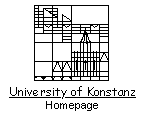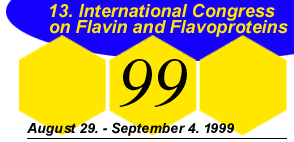


Download Preparation-Guide as Word-file | PDF-file
Download sample as Word-file | PDF-file
Note: Download sample.gif or go to page 3 of the sample.pdf for details about how the pages must be formated for reproduction.
Rudolf Weber, Dr.-Ing.
Bartningallee 7
D–10557 Berlin
Germany
Guide for the Preparation of Manuscripts Ready for Reproduction
( Camera–ready Manuscripts )
Please adhere strictly to the following instructions in order to ensure rapid publication. Examples are found on the sample manuscript.
Should problems or questions arise, please contact Rudolf Weber (see above), he is responsible for copy-editing and production of the Proceedings-Volume.
Reproduction
The submitted manuscrips must be suitable for reproduction. The ratio is 1:1 (one to one).
Format of the book (hardcover) is 17 cm x 24 cm.
The Typing Area is 13.5 cm x 19.5 cm (see sample.gif or sample.pdf). That means each full page of printed text has 43–44 lines.
Paper to be used
You can use either A4 format (21.0 cm x 29.7 cm) or format 21.7 cm x 28.0 cm (letter-head size).
For both formats the typing area must be the same: namely 13.5 cm x 19.5 cm.
For best reproduction please use high quality paper (80 g/m_ or 90 g/m_), to guarantee a very high contrast between black and white.
Typing Instructions
Text processing: Word 97 (PC; Windows 95 or Windows 98) or Word 98 for Mac should be used.
Font: „Times New Roman" or „Times". Avoid grotesque fonts such as „Helvetica".
The text should be typed by 11° (eleven point) Times New Roman and spaced by 12° (twelve points).
It can be increased to accommodate subscripts and superscripts, formulas, etc.
Italics and bold for emphasizing words or parts of the text can be used.
Also lowered and raised character formatting (sub- and superscripts) can be used.
Unusual symbols may be inserted by hand in black ink.
Very Important: Do not use hyphenation programs.
Printer: To use a Laser Printer is mandatory.
Submitting the manuscript
Hand over the manuscript personally to Dr. Rudolf Weber during the meeting.
Two printed versions of your manuscript together with a 3.5" / 90mm disk (always use new, preformatted disks), must be submitted.
The final version of the manuscript, identical with the printed manuscript, must be stored on the disk.
Absolute deadline for submitting manuscripts is definitely Friday, September 3rd, 1999.
We are planning to have the book in a printed form within two months after the meeting, and therefore no exception to this deadline will be made!
General
A standard dictionary of English should be used as the reference for spelling and punctuation.
Ensure that the orthography (British, American, etc.) is uniform throughout the text. This is particularly important for index preparation (see below).
Abbreviate units and measures in accordance with standard international norms.
Abbreviations used in the text should be defined the first time they appear in the text. If neccessary, a list of abbreviations may be given at the end of the contribution.
Use uniform wording in the legends / tables and in the body of the text and in captions to tables, etc.:
Chapter xx, Figure xx, or Table xx.
In cross-references: (Chap. xx), (Fig. xx), or (Table xx), etc.
Ragged right (edge): to set text with even spacing between words and ragged edge to the right is
the preferred form.
Justification: ordinary type set as a block with right-hand justification is also accepted. Processing of text in this way is sometimes more difficult.
Important: Do not separate terms or words that belong together.
Incorrect or ugly word divisions should be avoided at all costs.
Tables
Tables should be typed as part of the text. Please separate them from the text by a three-line space above and below the table.
The word „Table" followed by an Arabic numeral and the table title should be typed above the table beginning at the left-hand margin.
The table title should have first letters of all main words in capitals.
Tables should be inserted in the text as close to the point of reference as possible.
References
References in the text should be numbered consecutively by numbering in brackets.
The full reference list should be at the end of the text.
The references should be typed single spaced, although separated from one another by an extra line of space.
Please observe the following samples for proper citation:
Journal:
Norman D., Ulloa N., Brant-Zawadzki M., Gould R.G. (1985): Intraarterial Digital
Substraction Imaging Cost Considerations. Radiology 156, 33.
Yang J.-M., Goring D.A.I. (1980): Can. J. Chem. 58, 2411–2414.
Book:
Schinzel A.: Catalogue of Unbalanced Chromosome Aberrations in Man.
Walter de Gruyter, Berlin·New York (1984), pp. 718–737.
Steiner R.E., Sherwood T.: Recent Advances in Radiology and Managing.
Curchill and Livingstone, New York (1986).
Article in Book:
Thoeni R.F.: Computed Tomography of the Pelvis. In: Moss A. A., Gamsu G., Genant H.
(Eds.): Tomography of the Body. W.B. Saunders Co., Philadelphia (1983), pp. 987–1044.
Servos G., Touraine F., Quincy C. In: Arnaud P., Bienvenu J. Laurent P. (Eds.):
Marker Proteins in Inflammation, Vol. 2, Walter de Gruyter, Berlin New York (1984),
pp. 355-357.
Captions (Legends)
Captions, (legends) to figures should be typed single spaced, using Times New Roman or Times 11° (eleven point). A brief descriptive legend should be provided for each figure.
Illustrations and Formulas
All illustrations must be in a reproducible form.
Line drawings may be submitted in either of two ways: pasted in position on the page or attached to the page on which it will ultimately appear.
Labels on all line drawings must be at least 2.5 mm.
It is preferred that line drawings and graphics be incorporated into the text by means of a graphic program.
Photographs (half-tones; continues tones) must be attached (not pasted) to the page on which they will appear.
Please deliver the originals in black and white.
Please indicate the top of figures by marking TOP or using a directional arrow on the reverse side.
Photographs requiring reproduction by the printer should be marked with their final size on the reverse side of the illustration.
Sufficient blanc space must be left for all unmounted illustrations.
Illustrations should be placed as close to the text citation as possible. For simplicity, they should be placed at the top of bottom of the page; they must be centerd in the page.
Formula numbering should be written in parentheses after the formula at the extrem right-hand margin.
All formulas displayed should be centered on the page. Leave ample space above and below all displayed text.
Subject Index
Entries for the subject index with page reference must be submitted on a separate page.
Theses entries should include all pertinent statements made within the body of the text.
They should be detailed in content and show broad scope in their subdivisioning.
Example:
Medulla (main entry)
-, oblongata (1st subheading)
--, substance of (2nd subheading).
Pagination
The pages of the manuscript must be numbered consecutively in pencil. Use only a soft pencil, no ballpoint pen (biro); it must be possible to erase the pencil-writing very easily.
Please ensure that the page numbers appear outside the margin area.
Format of the Manuscript
The first page of each paper begins on line 1 with title in bold letters (12° Times New Roman or Times) followed by the author‘s (authors‘) name(s) and his (their) affiliations (11°; eleven point), as shown on the sample page.
Please organise the contents as follows (Results and Discussions may be combined):
Introduction
Materials and Methods (can be omitted if appropriate)
Results
Discussion (these two sections can be merged, and might be followed by a short „conclusion" section)
Acknowledgements (if desired)
References
Overorganisation of the manuscript should be avoided – chapters should be limited to two grades of internal subheadings.
- Please use 11° (eleven point) bold type for first-grade heads, capital and lower case
(i.e. initial capitals for all words except articles and prepositions). - Please use 11° (eleven point) italics for second-grade heads, initial capital and lower case
(i.e. only the first word begins with a capital letter, followed by lower case).
Begin at the left margin on a separate line.
For correct spacing see sample copy.
Paragraphs must begin at the left-hand margin.
For correct spacing between paragraphs see sample copy.
Please avoid starting a new page with the last few words of a paragraph.
Headlines should not be placed on the last line of a page; start a new page instead.
Length of manuscripts
Papers from invited speakers (state of the art lectures): 8 pages up to 10 pages (max.).
Papers from invited speakers (regular lectures): 6 pages up to 8 pages (max.).
Poster presentations: 4 pages (max.).
Note
Submission of a manuscript to this Proceeding-Volume implies that the work described has not been published before and is not under consideration for publication elsewhere. It is the corresponding author’s responsibility to ensure that all authors see the manuscript and approve of its submission for publication.
Once the manusript is accepted, it must not be published elsewhere without the consent of the copyright holders.
Frequent mistakes
Fractional numbers. Correct: 1.9; incorrect: 1,9
5-digit and large numbers. Correct: 50,000; incorrect: 50000
Dates. Correct: 1979–1989; incorrect: 1979-89 or 1979 – 1989
...to... ranges. Correct: 700 cm–800 cm; incorrect: 700-800cm or 700-800
Percentages. Correct: 3 %; incorrect: 3%
Degrees Celsius. Correct: 37 °C; incorrect: 37°C
Abbreviations. Correct: e.g., i.e.; incorrect: e. g., i. e.
...to... data. Correct: 3–4; incorrect: 3-4 or 3 – 4
Hyphen. Correct: word–word; incorrect : word – word, word-word.
Period (full stop) after abbreviations at end of sentence. Correct: etc. incorrect: etc..
Zero. Correct: 0; incorrect: o or O (small or capital „O")
Seconds. Correct: s; incorrect: sec
Minutes . Correct: min (without period)
Hours. Correct: h; incorrect: hrs
Day. Correct: d
1 km, 1 cm: using blanc space
„Times". Correct: 3–4 times; incorrect: 3-4 times, 3- to 4-times
Greater than/less than. Correct: < 10, > 100; incorrect: <10, >100
Approximate: Correct: ª
Conversions:
1 inch = 2.54 cm
1 cm = 0.3937 inch
Last update by Jens Grabenstein